Green Marketing Portfolio: Observation, Analysis, & Sustainability
VerifiedAdded on 2023/06/08
|16
|3829
|447
Report
AI Summary
This report presents a comprehensive analysis of green marketing, focusing on the theory and practical applications within a business context. It begins with an introduction to the concept of green marketing and its increasing importance in today's environmentally conscious world, using Nescafe as a case study. The report identifies the brand's priority audience and develops psychographic profiles, followed by a critique and analysis of Nescafe's green marketing strategies. Strategic sustainability recommendations are provided, addressing supply chain delivery, leveraging new sustainability product lines, and repositioning the brand image. The report also includes a personal learning reflection, highlighting the key takeaways and insights gained from the project, concluding with a summary of the findings and recommendations, supported by a list of references.
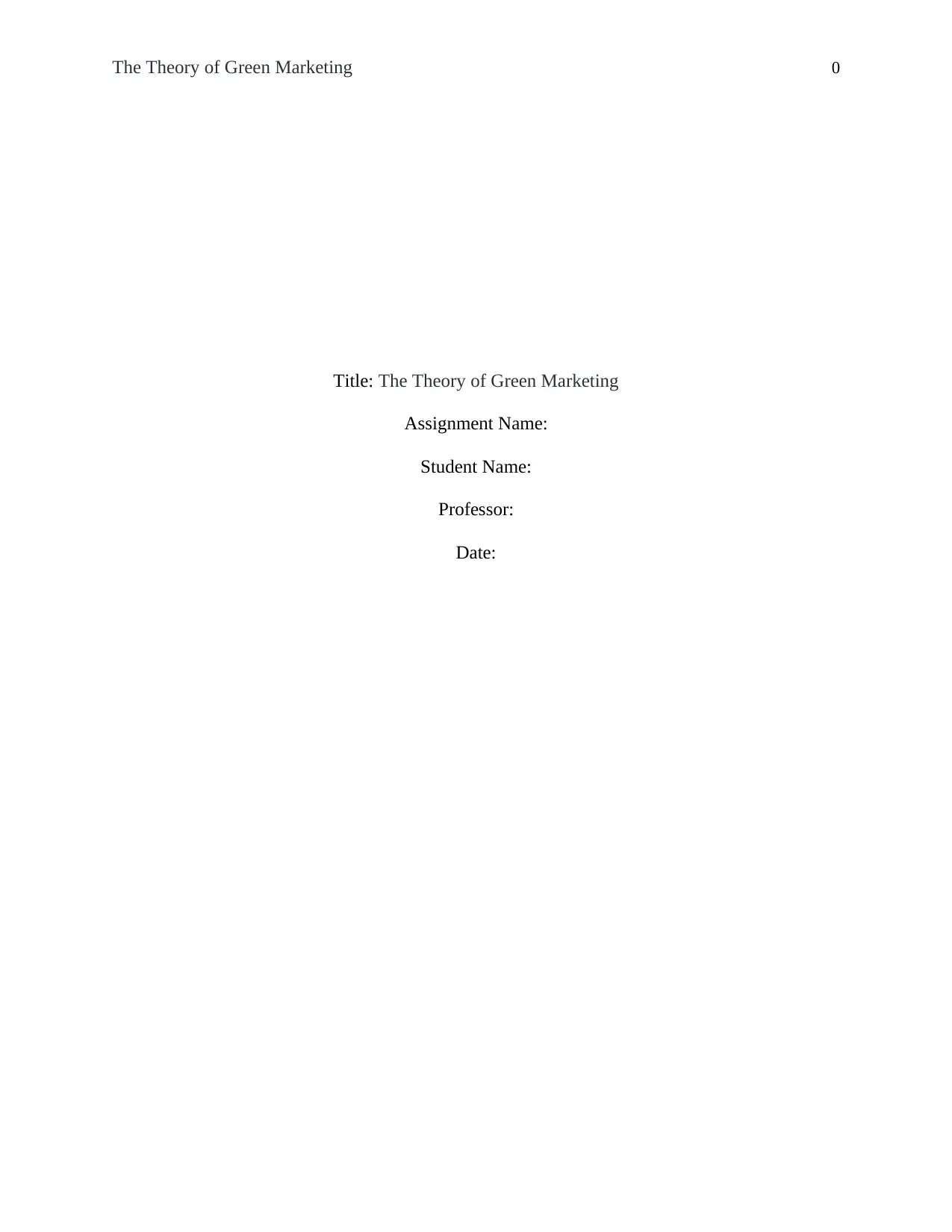
The Theory of Green Marketing 0
Title: The Theory of Green Marketing
Assignment Name:
Student Name:
Professor:
Date:
Title: The Theory of Green Marketing
Assignment Name:
Student Name:
Professor:
Date:
Paraphrase This Document
Need a fresh take? Get an instant paraphrase of this document with our AI Paraphraser
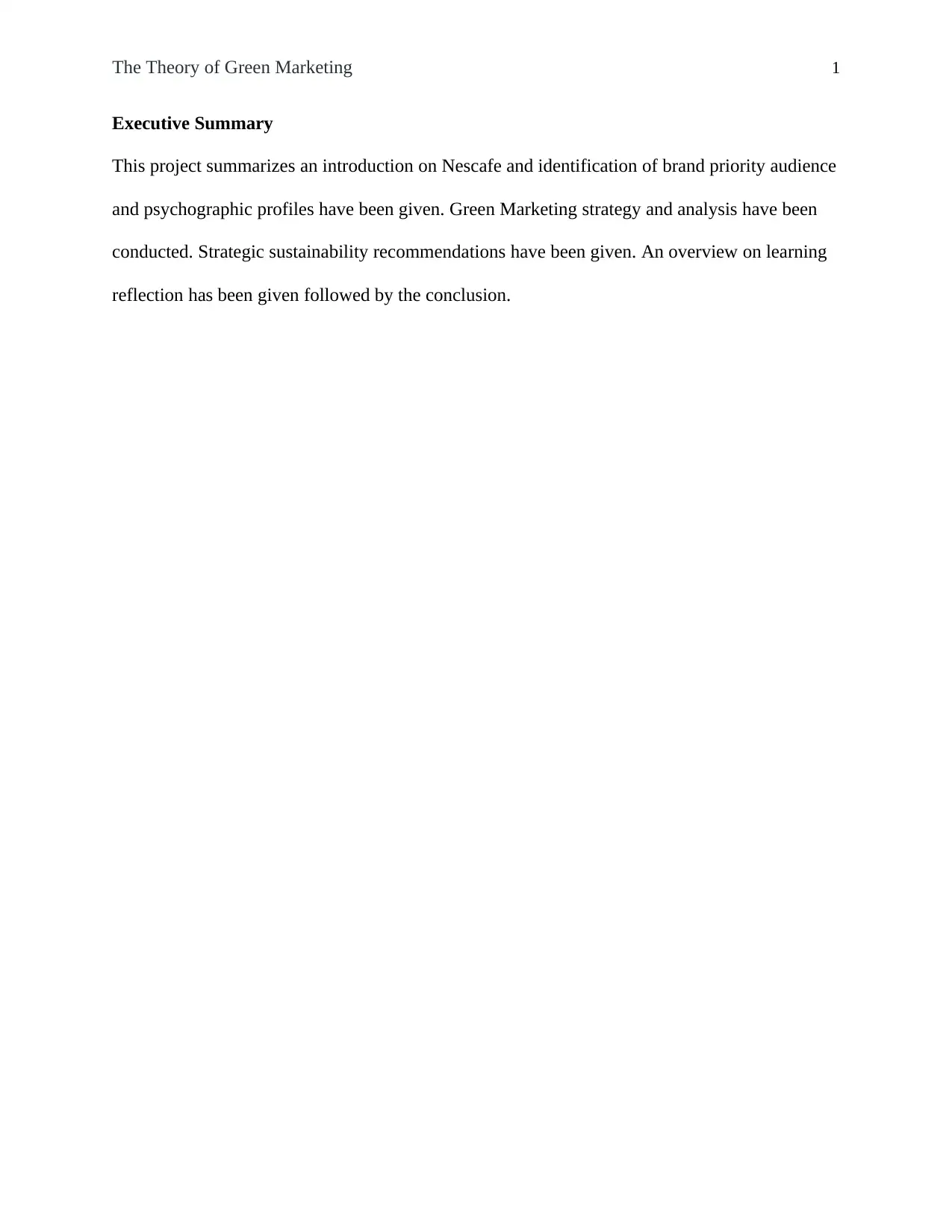
The Theory of Green Marketing 1
Executive Summary
This project summarizes an introduction on Nescafe and identification of brand priority audience
and psychographic profiles have been given. Green Marketing strategy and analysis have been
conducted. Strategic sustainability recommendations have been given. An overview on learning
reflection has been given followed by the conclusion.
Executive Summary
This project summarizes an introduction on Nescafe and identification of brand priority audience
and psychographic profiles have been given. Green Marketing strategy and analysis have been
conducted. Strategic sustainability recommendations have been given. An overview on learning
reflection has been given followed by the conclusion.

The Theory of Green Marketing 2
Contents
Introduction......................................................................................................................................3
Identify Brand Priority Audience and Psychographic Profile.........................................................3
Green Marketing Strategy Critique and Analysis............................................................................5
Strategic Sustainability Recommendations.....................................................................................8
Learning Reflection.......................................................................................................................10
Conclusion.....................................................................................................................................12
References......................................................................................................................................13
Contents
Introduction......................................................................................................................................3
Identify Brand Priority Audience and Psychographic Profile.........................................................3
Green Marketing Strategy Critique and Analysis............................................................................5
Strategic Sustainability Recommendations.....................................................................................8
Learning Reflection.......................................................................................................................10
Conclusion.....................................................................................................................................12
References......................................................................................................................................13
⊘ This is a preview!⊘
Do you want full access?
Subscribe today to unlock all pages.

Trusted by 1+ million students worldwide
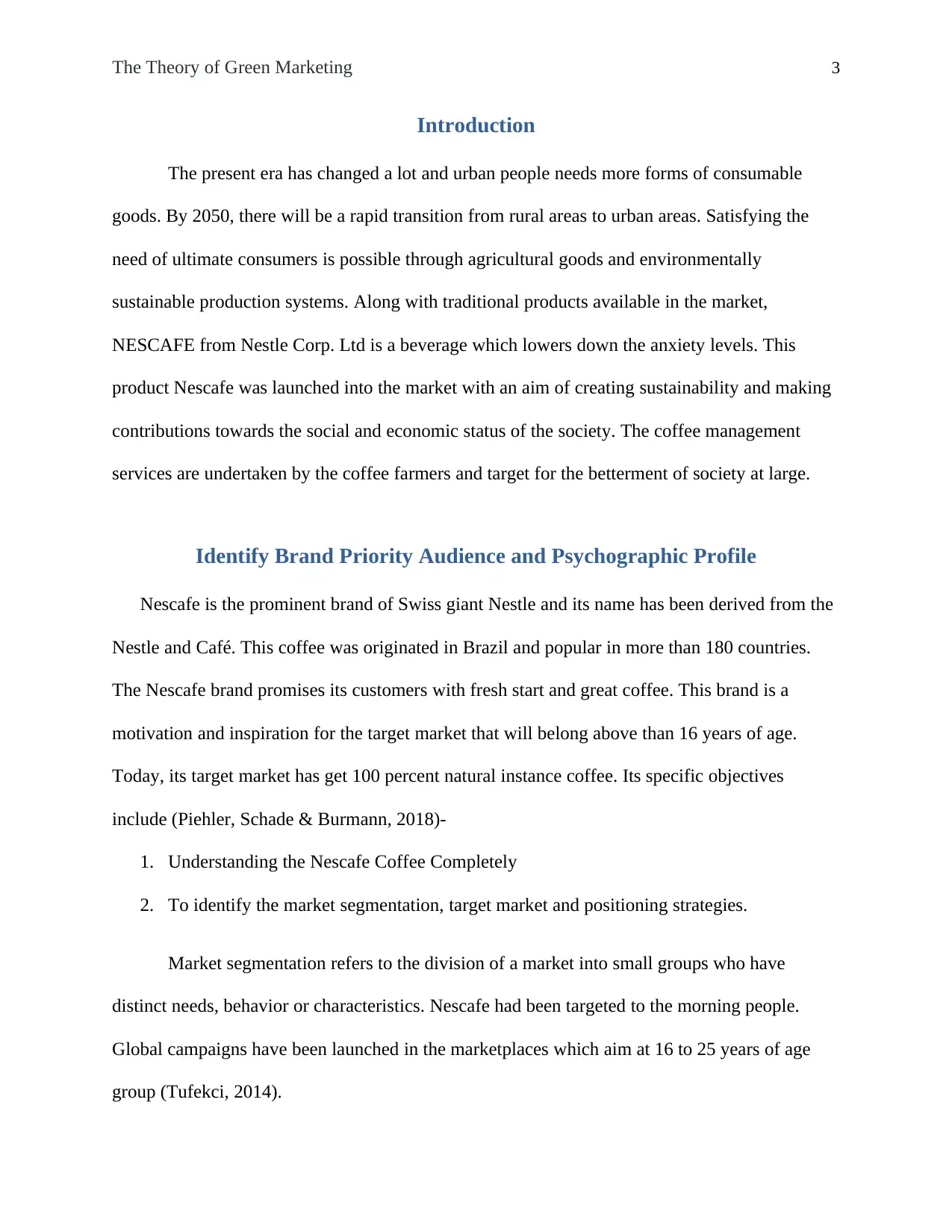
The Theory of Green Marketing 3
Introduction
The present era has changed a lot and urban people needs more forms of consumable
goods. By 2050, there will be a rapid transition from rural areas to urban areas. Satisfying the
need of ultimate consumers is possible through agricultural goods and environmentally
sustainable production systems. Along with traditional products available in the market,
NESCAFE from Nestle Corp. Ltd is a beverage which lowers down the anxiety levels. This
product Nescafe was launched into the market with an aim of creating sustainability and making
contributions towards the social and economic status of the society. The coffee management
services are undertaken by the coffee farmers and target for the betterment of society at large.
Identify Brand Priority Audience and Psychographic Profile
Nescafe is the prominent brand of Swiss giant Nestle and its name has been derived from the
Nestle and Café. This coffee was originated in Brazil and popular in more than 180 countries.
The Nescafe brand promises its customers with fresh start and great coffee. This brand is a
motivation and inspiration for the target market that will belong above than 16 years of age.
Today, its target market has get 100 percent natural instance coffee. Its specific objectives
include (Piehler, Schade & Burmann, 2018)-
1. Understanding the Nescafe Coffee Completely
2. To identify the market segmentation, target market and positioning strategies.
Market segmentation refers to the division of a market into small groups who have
distinct needs, behavior or characteristics. Nescafe had been targeted to the morning people.
Global campaigns have been launched in the marketplaces which aim at 16 to 25 years of age
group (Tufekci, 2014).
Introduction
The present era has changed a lot and urban people needs more forms of consumable
goods. By 2050, there will be a rapid transition from rural areas to urban areas. Satisfying the
need of ultimate consumers is possible through agricultural goods and environmentally
sustainable production systems. Along with traditional products available in the market,
NESCAFE from Nestle Corp. Ltd is a beverage which lowers down the anxiety levels. This
product Nescafe was launched into the market with an aim of creating sustainability and making
contributions towards the social and economic status of the society. The coffee management
services are undertaken by the coffee farmers and target for the betterment of society at large.
Identify Brand Priority Audience and Psychographic Profile
Nescafe is the prominent brand of Swiss giant Nestle and its name has been derived from the
Nestle and Café. This coffee was originated in Brazil and popular in more than 180 countries.
The Nescafe brand promises its customers with fresh start and great coffee. This brand is a
motivation and inspiration for the target market that will belong above than 16 years of age.
Today, its target market has get 100 percent natural instance coffee. Its specific objectives
include (Piehler, Schade & Burmann, 2018)-
1. Understanding the Nescafe Coffee Completely
2. To identify the market segmentation, target market and positioning strategies.
Market segmentation refers to the division of a market into small groups who have
distinct needs, behavior or characteristics. Nescafe had been targeted to the morning people.
Global campaigns have been launched in the marketplaces which aim at 16 to 25 years of age
group (Tufekci, 2014).
Paraphrase This Document
Need a fresh take? Get an instant paraphrase of this document with our AI Paraphraser
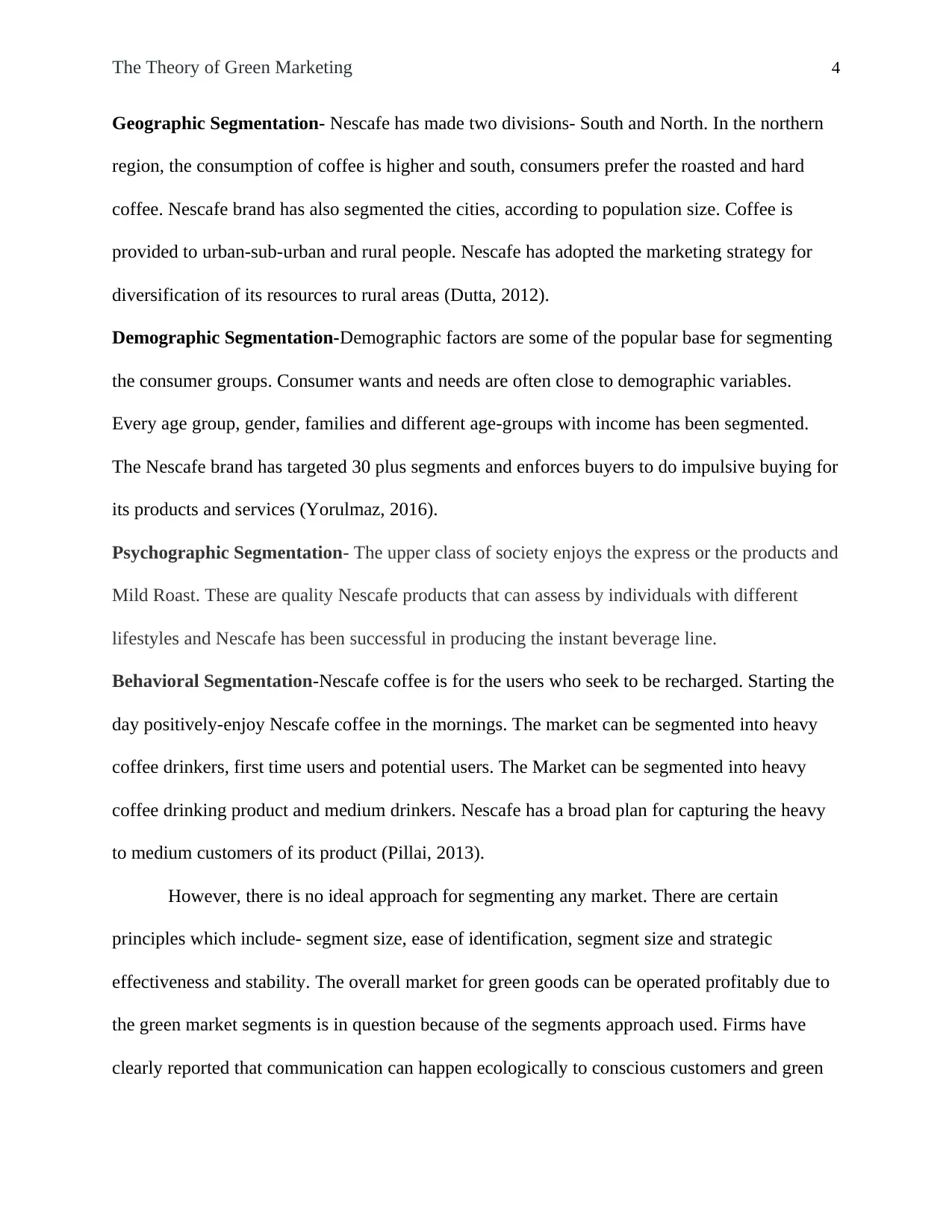
The Theory of Green Marketing 4
Geographic Segmentation- Nescafe has made two divisions- South and North. In the northern
region, the consumption of coffee is higher and south, consumers prefer the roasted and hard
coffee. Nescafe brand has also segmented the cities, according to population size. Coffee is
provided to urban-sub-urban and rural people. Nescafe has adopted the marketing strategy for
diversification of its resources to rural areas (Dutta, 2012).
Demographic Segmentation-Demographic factors are some of the popular base for segmenting
the consumer groups. Consumer wants and needs are often close to demographic variables.
Every age group, gender, families and different age-groups with income has been segmented.
The Nescafe brand has targeted 30 plus segments and enforces buyers to do impulsive buying for
its products and services (Yorulmaz, 2016).
Psychographic Segmentation- The upper class of society enjoys the express or the products and
Mild Roast. These are quality Nescafe products that can assess by individuals with different
lifestyles and Nescafe has been successful in producing the instant beverage line.
Behavioral Segmentation-Nescafe coffee is for the users who seek to be recharged. Starting the
day positively-enjoy Nescafe coffee in the mornings. The market can be segmented into heavy
coffee drinkers, first time users and potential users. The Market can be segmented into heavy
coffee drinking product and medium drinkers. Nescafe has a broad plan for capturing the heavy
to medium customers of its product (Pillai, 2013).
However, there is no ideal approach for segmenting any market. There are certain
principles which include- segment size, ease of identification, segment size and strategic
effectiveness and stability. The overall market for green goods can be operated profitably due to
the green market segments is in question because of the segments approach used. Firms have
clearly reported that communication can happen ecologically to conscious customers and green
Geographic Segmentation- Nescafe has made two divisions- South and North. In the northern
region, the consumption of coffee is higher and south, consumers prefer the roasted and hard
coffee. Nescafe brand has also segmented the cities, according to population size. Coffee is
provided to urban-sub-urban and rural people. Nescafe has adopted the marketing strategy for
diversification of its resources to rural areas (Dutta, 2012).
Demographic Segmentation-Demographic factors are some of the popular base for segmenting
the consumer groups. Consumer wants and needs are often close to demographic variables.
Every age group, gender, families and different age-groups with income has been segmented.
The Nescafe brand has targeted 30 plus segments and enforces buyers to do impulsive buying for
its products and services (Yorulmaz, 2016).
Psychographic Segmentation- The upper class of society enjoys the express or the products and
Mild Roast. These are quality Nescafe products that can assess by individuals with different
lifestyles and Nescafe has been successful in producing the instant beverage line.
Behavioral Segmentation-Nescafe coffee is for the users who seek to be recharged. Starting the
day positively-enjoy Nescafe coffee in the mornings. The market can be segmented into heavy
coffee drinkers, first time users and potential users. The Market can be segmented into heavy
coffee drinking product and medium drinkers. Nescafe has a broad plan for capturing the heavy
to medium customers of its product (Pillai, 2013).
However, there is no ideal approach for segmenting any market. There are certain
principles which include- segment size, ease of identification, segment size and strategic
effectiveness and stability. The overall market for green goods can be operated profitably due to
the green market segments is in question because of the segments approach used. Firms have
clearly reported that communication can happen ecologically to conscious customers and green
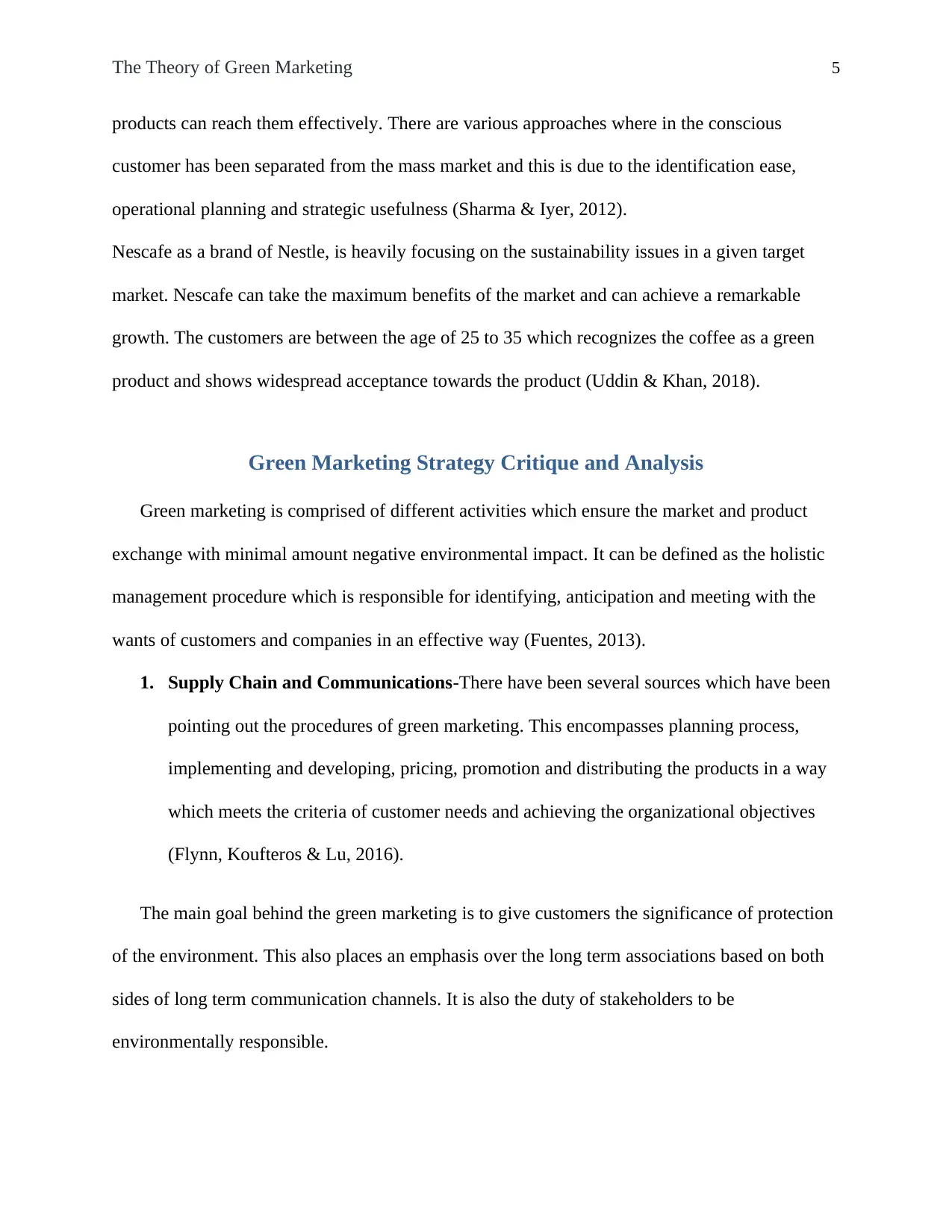
The Theory of Green Marketing 5
products can reach them effectively. There are various approaches where in the conscious
customer has been separated from the mass market and this is due to the identification ease,
operational planning and strategic usefulness (Sharma & Iyer, 2012).
Nescafe as a brand of Nestle, is heavily focusing on the sustainability issues in a given target
market. Nescafe can take the maximum benefits of the market and can achieve a remarkable
growth. The customers are between the age of 25 to 35 which recognizes the coffee as a green
product and shows widespread acceptance towards the product (Uddin & Khan, 2018).
Green Marketing Strategy Critique and Analysis
Green marketing is comprised of different activities which ensure the market and product
exchange with minimal amount negative environmental impact. It can be defined as the holistic
management procedure which is responsible for identifying, anticipation and meeting with the
wants of customers and companies in an effective way (Fuentes, 2013).
1. Supply Chain and Communications-There have been several sources which have been
pointing out the procedures of green marketing. This encompasses planning process,
implementing and developing, pricing, promotion and distributing the products in a way
which meets the criteria of customer needs and achieving the organizational objectives
(Flynn, Koufteros & Lu, 2016).
The main goal behind the green marketing is to give customers the significance of protection
of the environment. This also places an emphasis over the long term associations based on both
sides of long term communication channels. It is also the duty of stakeholders to be
environmentally responsible.
products can reach them effectively. There are various approaches where in the conscious
customer has been separated from the mass market and this is due to the identification ease,
operational planning and strategic usefulness (Sharma & Iyer, 2012).
Nescafe as a brand of Nestle, is heavily focusing on the sustainability issues in a given target
market. Nescafe can take the maximum benefits of the market and can achieve a remarkable
growth. The customers are between the age of 25 to 35 which recognizes the coffee as a green
product and shows widespread acceptance towards the product (Uddin & Khan, 2018).
Green Marketing Strategy Critique and Analysis
Green marketing is comprised of different activities which ensure the market and product
exchange with minimal amount negative environmental impact. It can be defined as the holistic
management procedure which is responsible for identifying, anticipation and meeting with the
wants of customers and companies in an effective way (Fuentes, 2013).
1. Supply Chain and Communications-There have been several sources which have been
pointing out the procedures of green marketing. This encompasses planning process,
implementing and developing, pricing, promotion and distributing the products in a way
which meets the criteria of customer needs and achieving the organizational objectives
(Flynn, Koufteros & Lu, 2016).
The main goal behind the green marketing is to give customers the significance of protection
of the environment. This also places an emphasis over the long term associations based on both
sides of long term communication channels. It is also the duty of stakeholders to be
environmentally responsible.
⊘ This is a preview!⊘
Do you want full access?
Subscribe today to unlock all pages.

Trusted by 1+ million students worldwide
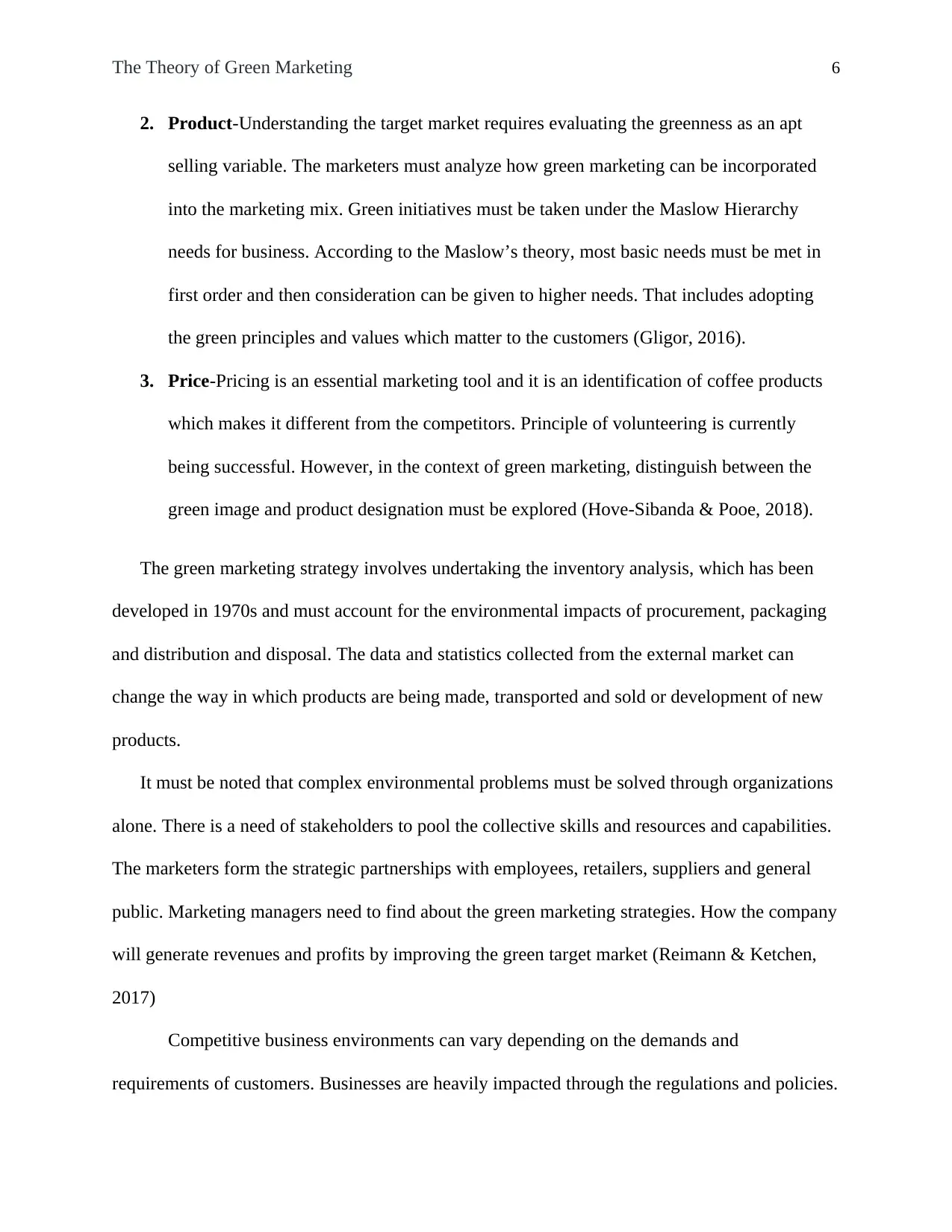
The Theory of Green Marketing 6
2. Product-Understanding the target market requires evaluating the greenness as an apt
selling variable. The marketers must analyze how green marketing can be incorporated
into the marketing mix. Green initiatives must be taken under the Maslow Hierarchy
needs for business. According to the Maslow’s theory, most basic needs must be met in
first order and then consideration can be given to higher needs. That includes adopting
the green principles and values which matter to the customers (Gligor, 2016).
3. Price-Pricing is an essential marketing tool and it is an identification of coffee products
which makes it different from the competitors. Principle of volunteering is currently
being successful. However, in the context of green marketing, distinguish between the
green image and product designation must be explored (Hove-Sibanda & Pooe, 2018).
The green marketing strategy involves undertaking the inventory analysis, which has been
developed in 1970s and must account for the environmental impacts of procurement, packaging
and distribution and disposal. The data and statistics collected from the external market can
change the way in which products are being made, transported and sold or development of new
products.
It must be noted that complex environmental problems must be solved through organizations
alone. There is a need of stakeholders to pool the collective skills and resources and capabilities.
The marketers form the strategic partnerships with employees, retailers, suppliers and general
public. Marketing managers need to find about the green marketing strategies. How the company
will generate revenues and profits by improving the green target market (Reimann & Ketchen,
2017)
Competitive business environments can vary depending on the demands and
requirements of customers. Businesses are heavily impacted through the regulations and policies.
2. Product-Understanding the target market requires evaluating the greenness as an apt
selling variable. The marketers must analyze how green marketing can be incorporated
into the marketing mix. Green initiatives must be taken under the Maslow Hierarchy
needs for business. According to the Maslow’s theory, most basic needs must be met in
first order and then consideration can be given to higher needs. That includes adopting
the green principles and values which matter to the customers (Gligor, 2016).
3. Price-Pricing is an essential marketing tool and it is an identification of coffee products
which makes it different from the competitors. Principle of volunteering is currently
being successful. However, in the context of green marketing, distinguish between the
green image and product designation must be explored (Hove-Sibanda & Pooe, 2018).
The green marketing strategy involves undertaking the inventory analysis, which has been
developed in 1970s and must account for the environmental impacts of procurement, packaging
and distribution and disposal. The data and statistics collected from the external market can
change the way in which products are being made, transported and sold or development of new
products.
It must be noted that complex environmental problems must be solved through organizations
alone. There is a need of stakeholders to pool the collective skills and resources and capabilities.
The marketers form the strategic partnerships with employees, retailers, suppliers and general
public. Marketing managers need to find about the green marketing strategies. How the company
will generate revenues and profits by improving the green target market (Reimann & Ketchen,
2017)
Competitive business environments can vary depending on the demands and
requirements of customers. Businesses are heavily impacted through the regulations and policies.
Paraphrase This Document
Need a fresh take? Get an instant paraphrase of this document with our AI Paraphraser
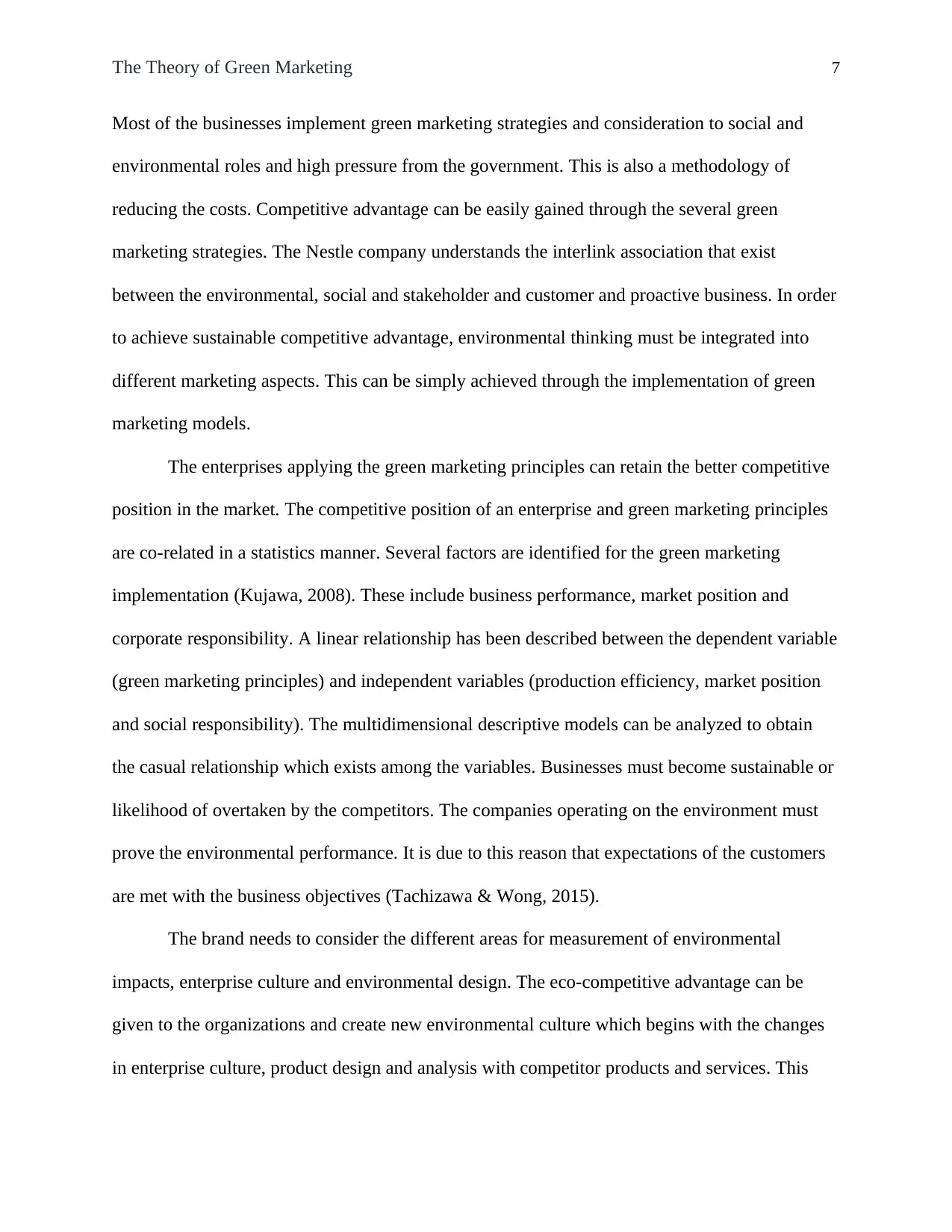
The Theory of Green Marketing 7
Most of the businesses implement green marketing strategies and consideration to social and
environmental roles and high pressure from the government. This is also a methodology of
reducing the costs. Competitive advantage can be easily gained through the several green
marketing strategies. The Nestle company understands the interlink association that exist
between the environmental, social and stakeholder and customer and proactive business. In order
to achieve sustainable competitive advantage, environmental thinking must be integrated into
different marketing aspects. This can be simply achieved through the implementation of green
marketing models.
The enterprises applying the green marketing principles can retain the better competitive
position in the market. The competitive position of an enterprise and green marketing principles
are co-related in a statistics manner. Several factors are identified for the green marketing
implementation (Kujawa, 2008). These include business performance, market position and
corporate responsibility. A linear relationship has been described between the dependent variable
(green marketing principles) and independent variables (production efficiency, market position
and social responsibility). The multidimensional descriptive models can be analyzed to obtain
the casual relationship which exists among the variables. Businesses must become sustainable or
likelihood of overtaken by the competitors. The companies operating on the environment must
prove the environmental performance. It is due to this reason that expectations of the customers
are met with the business objectives (Tachizawa & Wong, 2015).
The brand needs to consider the different areas for measurement of environmental
impacts, enterprise culture and environmental design. The eco-competitive advantage can be
given to the organizations and create new environmental culture which begins with the changes
in enterprise culture, product design and analysis with competitor products and services. This
Most of the businesses implement green marketing strategies and consideration to social and
environmental roles and high pressure from the government. This is also a methodology of
reducing the costs. Competitive advantage can be easily gained through the several green
marketing strategies. The Nestle company understands the interlink association that exist
between the environmental, social and stakeholder and customer and proactive business. In order
to achieve sustainable competitive advantage, environmental thinking must be integrated into
different marketing aspects. This can be simply achieved through the implementation of green
marketing models.
The enterprises applying the green marketing principles can retain the better competitive
position in the market. The competitive position of an enterprise and green marketing principles
are co-related in a statistics manner. Several factors are identified for the green marketing
implementation (Kujawa, 2008). These include business performance, market position and
corporate responsibility. A linear relationship has been described between the dependent variable
(green marketing principles) and independent variables (production efficiency, market position
and social responsibility). The multidimensional descriptive models can be analyzed to obtain
the casual relationship which exists among the variables. Businesses must become sustainable or
likelihood of overtaken by the competitors. The companies operating on the environment must
prove the environmental performance. It is due to this reason that expectations of the customers
are met with the business objectives (Tachizawa & Wong, 2015).
The brand needs to consider the different areas for measurement of environmental
impacts, enterprise culture and environmental design. The eco-competitive advantage can be
given to the organizations and create new environmental culture which begins with the changes
in enterprise culture, product design and analysis with competitor products and services. This
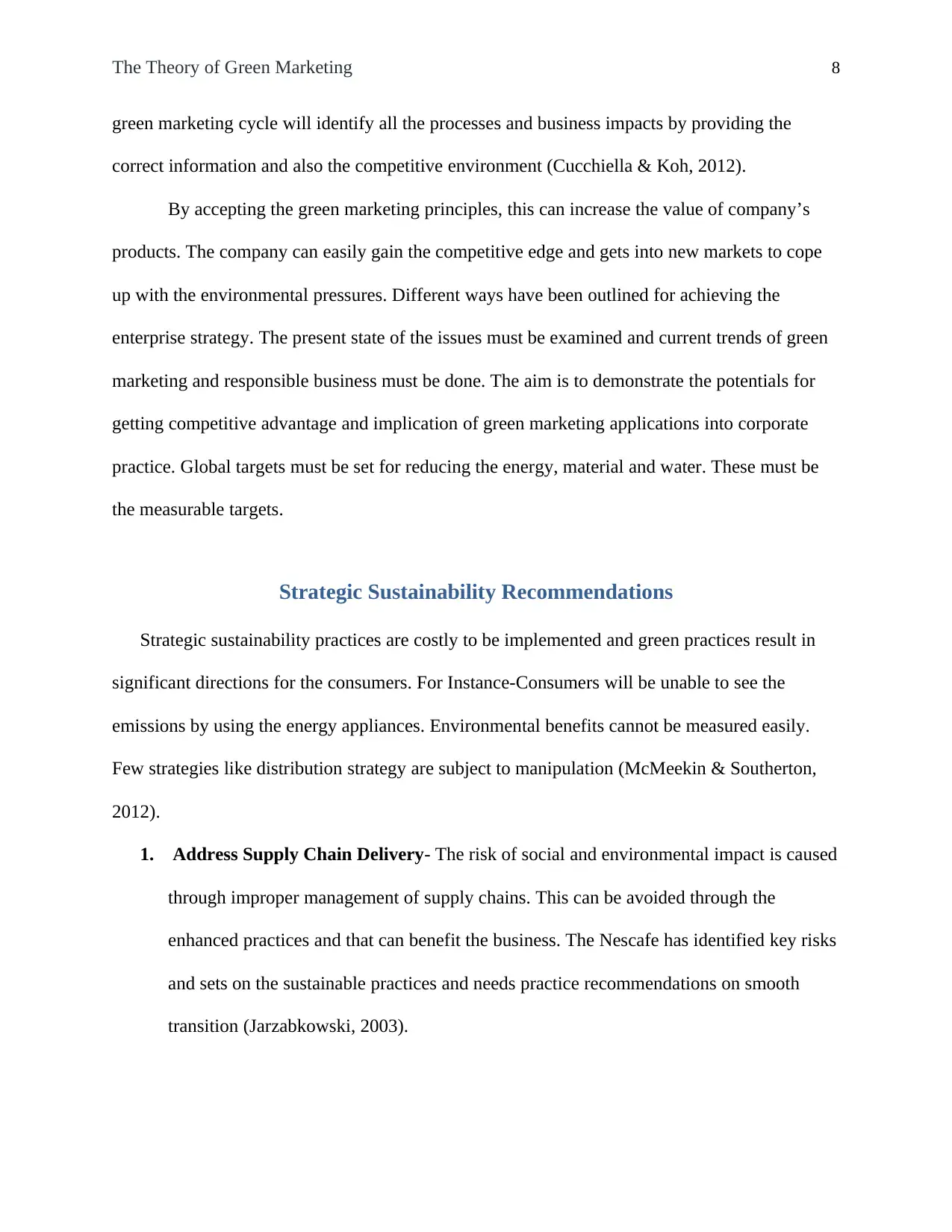
The Theory of Green Marketing 8
green marketing cycle will identify all the processes and business impacts by providing the
correct information and also the competitive environment (Cucchiella & Koh, 2012).
By accepting the green marketing principles, this can increase the value of company’s
products. The company can easily gain the competitive edge and gets into new markets to cope
up with the environmental pressures. Different ways have been outlined for achieving the
enterprise strategy. The present state of the issues must be examined and current trends of green
marketing and responsible business must be done. The aim is to demonstrate the potentials for
getting competitive advantage and implication of green marketing applications into corporate
practice. Global targets must be set for reducing the energy, material and water. These must be
the measurable targets.
Strategic Sustainability Recommendations
Strategic sustainability practices are costly to be implemented and green practices result in
significant directions for the consumers. For Instance-Consumers will be unable to see the
emissions by using the energy appliances. Environmental benefits cannot be measured easily.
Few strategies like distribution strategy are subject to manipulation (McMeekin & Southerton,
2012).
1. Address Supply Chain Delivery- The risk of social and environmental impact is caused
through improper management of supply chains. This can be avoided through the
enhanced practices and that can benefit the business. The Nescafe has identified key risks
and sets on the sustainable practices and needs practice recommendations on smooth
transition (Jarzabkowski, 2003).
green marketing cycle will identify all the processes and business impacts by providing the
correct information and also the competitive environment (Cucchiella & Koh, 2012).
By accepting the green marketing principles, this can increase the value of company’s
products. The company can easily gain the competitive edge and gets into new markets to cope
up with the environmental pressures. Different ways have been outlined for achieving the
enterprise strategy. The present state of the issues must be examined and current trends of green
marketing and responsible business must be done. The aim is to demonstrate the potentials for
getting competitive advantage and implication of green marketing applications into corporate
practice. Global targets must be set for reducing the energy, material and water. These must be
the measurable targets.
Strategic Sustainability Recommendations
Strategic sustainability practices are costly to be implemented and green practices result in
significant directions for the consumers. For Instance-Consumers will be unable to see the
emissions by using the energy appliances. Environmental benefits cannot be measured easily.
Few strategies like distribution strategy are subject to manipulation (McMeekin & Southerton,
2012).
1. Address Supply Chain Delivery- The risk of social and environmental impact is caused
through improper management of supply chains. This can be avoided through the
enhanced practices and that can benefit the business. The Nescafe has identified key risks
and sets on the sustainable practices and needs practice recommendations on smooth
transition (Jarzabkowski, 2003).
⊘ This is a preview!⊘
Do you want full access?
Subscribe today to unlock all pages.

Trusted by 1+ million students worldwide
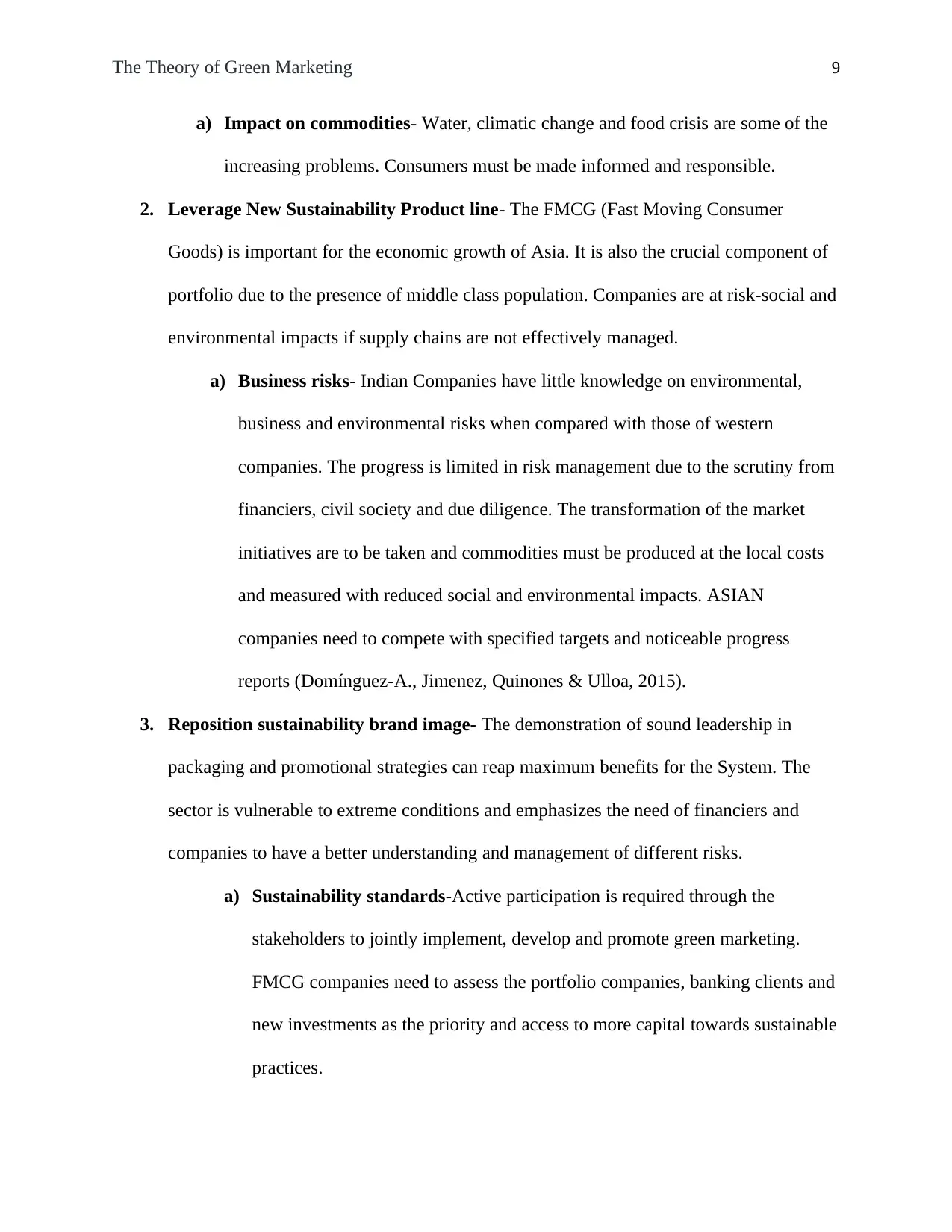
The Theory of Green Marketing 9
a) Impact on commodities- Water, climatic change and food crisis are some of the
increasing problems. Consumers must be made informed and responsible.
2. Leverage New Sustainability Product line- The FMCG (Fast Moving Consumer
Goods) is important for the economic growth of Asia. It is also the crucial component of
portfolio due to the presence of middle class population. Companies are at risk-social and
environmental impacts if supply chains are not effectively managed.
a) Business risks- Indian Companies have little knowledge on environmental,
business and environmental risks when compared with those of western
companies. The progress is limited in risk management due to the scrutiny from
financiers, civil society and due diligence. The transformation of the market
initiatives are to be taken and commodities must be produced at the local costs
and measured with reduced social and environmental impacts. ASIAN
companies need to compete with specified targets and noticeable progress
reports (Domínguez-A., Jimenez, Quinones & Ulloa, 2015).
3. Reposition sustainability brand image- The demonstration of sound leadership in
packaging and promotional strategies can reap maximum benefits for the System. The
sector is vulnerable to extreme conditions and emphasizes the need of financiers and
companies to have a better understanding and management of different risks.
a) Sustainability standards-Active participation is required through the
stakeholders to jointly implement, develop and promote green marketing.
FMCG companies need to assess the portfolio companies, banking clients and
new investments as the priority and access to more capital towards sustainable
practices.
a) Impact on commodities- Water, climatic change and food crisis are some of the
increasing problems. Consumers must be made informed and responsible.
2. Leverage New Sustainability Product line- The FMCG (Fast Moving Consumer
Goods) is important for the economic growth of Asia. It is also the crucial component of
portfolio due to the presence of middle class population. Companies are at risk-social and
environmental impacts if supply chains are not effectively managed.
a) Business risks- Indian Companies have little knowledge on environmental,
business and environmental risks when compared with those of western
companies. The progress is limited in risk management due to the scrutiny from
financiers, civil society and due diligence. The transformation of the market
initiatives are to be taken and commodities must be produced at the local costs
and measured with reduced social and environmental impacts. ASIAN
companies need to compete with specified targets and noticeable progress
reports (Domínguez-A., Jimenez, Quinones & Ulloa, 2015).
3. Reposition sustainability brand image- The demonstration of sound leadership in
packaging and promotional strategies can reap maximum benefits for the System. The
sector is vulnerable to extreme conditions and emphasizes the need of financiers and
companies to have a better understanding and management of different risks.
a) Sustainability standards-Active participation is required through the
stakeholders to jointly implement, develop and promote green marketing.
FMCG companies need to assess the portfolio companies, banking clients and
new investments as the priority and access to more capital towards sustainable
practices.
Paraphrase This Document
Need a fresh take? Get an instant paraphrase of this document with our AI Paraphraser
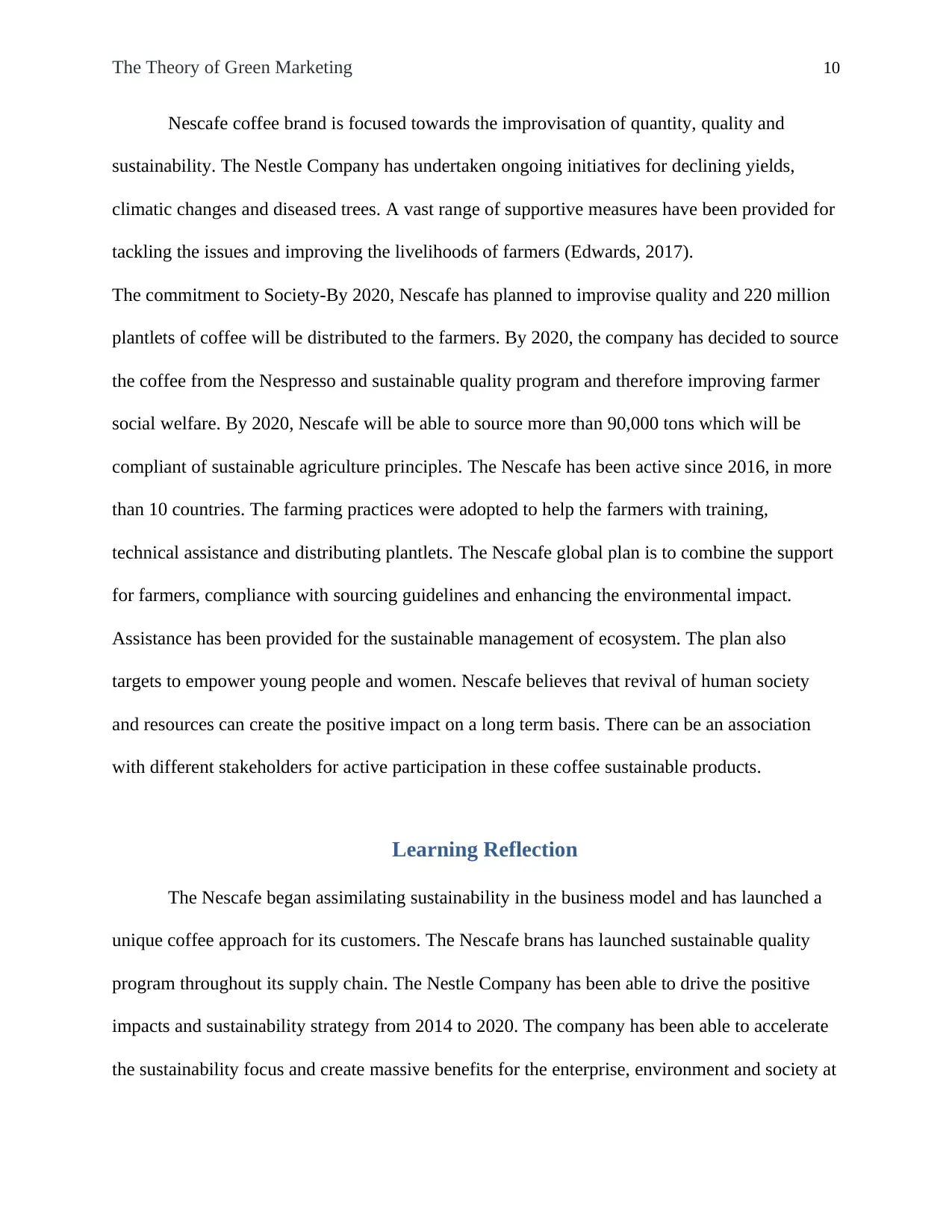
The Theory of Green Marketing 10
Nescafe coffee brand is focused towards the improvisation of quantity, quality and
sustainability. The Nestle Company has undertaken ongoing initiatives for declining yields,
climatic changes and diseased trees. A vast range of supportive measures have been provided for
tackling the issues and improving the livelihoods of farmers (Edwards, 2017).
The commitment to Society-By 2020, Nescafe has planned to improvise quality and 220 million
plantlets of coffee will be distributed to the farmers. By 2020, the company has decided to source
the coffee from the Nespresso and sustainable quality program and therefore improving farmer
social welfare. By 2020, Nescafe will be able to source more than 90,000 tons which will be
compliant of sustainable agriculture principles. The Nescafe has been active since 2016, in more
than 10 countries. The farming practices were adopted to help the farmers with training,
technical assistance and distributing plantlets. The Nescafe global plan is to combine the support
for farmers, compliance with sourcing guidelines and enhancing the environmental impact.
Assistance has been provided for the sustainable management of ecosystem. The plan also
targets to empower young people and women. Nescafe believes that revival of human society
and resources can create the positive impact on a long term basis. There can be an association
with different stakeholders for active participation in these coffee sustainable products.
Learning Reflection
The Nescafe began assimilating sustainability in the business model and has launched a
unique coffee approach for its customers. The Nescafe brans has launched sustainable quality
program throughout its supply chain. The Nestle Company has been able to drive the positive
impacts and sustainability strategy from 2014 to 2020. The company has been able to accelerate
the sustainability focus and create massive benefits for the enterprise, environment and society at
Nescafe coffee brand is focused towards the improvisation of quantity, quality and
sustainability. The Nestle Company has undertaken ongoing initiatives for declining yields,
climatic changes and diseased trees. A vast range of supportive measures have been provided for
tackling the issues and improving the livelihoods of farmers (Edwards, 2017).
The commitment to Society-By 2020, Nescafe has planned to improvise quality and 220 million
plantlets of coffee will be distributed to the farmers. By 2020, the company has decided to source
the coffee from the Nespresso and sustainable quality program and therefore improving farmer
social welfare. By 2020, Nescafe will be able to source more than 90,000 tons which will be
compliant of sustainable agriculture principles. The Nescafe has been active since 2016, in more
than 10 countries. The farming practices were adopted to help the farmers with training,
technical assistance and distributing plantlets. The Nescafe global plan is to combine the support
for farmers, compliance with sourcing guidelines and enhancing the environmental impact.
Assistance has been provided for the sustainable management of ecosystem. The plan also
targets to empower young people and women. Nescafe believes that revival of human society
and resources can create the positive impact on a long term basis. There can be an association
with different stakeholders for active participation in these coffee sustainable products.
Learning Reflection
The Nescafe began assimilating sustainability in the business model and has launched a
unique coffee approach for its customers. The Nescafe brans has launched sustainable quality
program throughout its supply chain. The Nestle Company has been able to drive the positive
impacts and sustainability strategy from 2014 to 2020. The company has been able to accelerate
the sustainability focus and create massive benefits for the enterprise, environment and society at
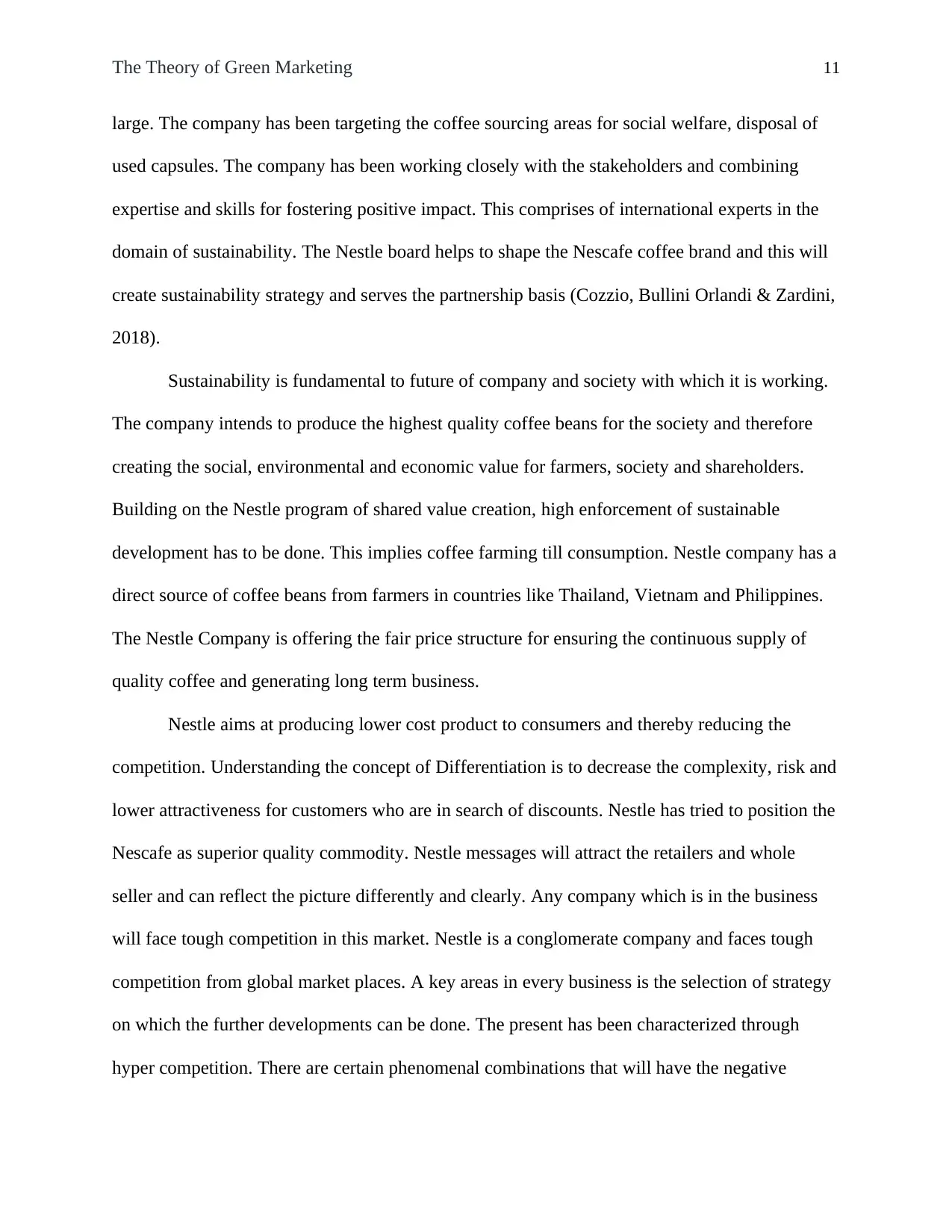
The Theory of Green Marketing 11
large. The company has been targeting the coffee sourcing areas for social welfare, disposal of
used capsules. The company has been working closely with the stakeholders and combining
expertise and skills for fostering positive impact. This comprises of international experts in the
domain of sustainability. The Nestle board helps to shape the Nescafe coffee brand and this will
create sustainability strategy and serves the partnership basis (Cozzio, Bullini Orlandi & Zardini,
2018).
Sustainability is fundamental to future of company and society with which it is working.
The company intends to produce the highest quality coffee beans for the society and therefore
creating the social, environmental and economic value for farmers, society and shareholders.
Building on the Nestle program of shared value creation, high enforcement of sustainable
development has to be done. This implies coffee farming till consumption. Nestle company has a
direct source of coffee beans from farmers in countries like Thailand, Vietnam and Philippines.
The Nestle Company is offering the fair price structure for ensuring the continuous supply of
quality coffee and generating long term business.
Nestle aims at producing lower cost product to consumers and thereby reducing the
competition. Understanding the concept of Differentiation is to decrease the complexity, risk and
lower attractiveness for customers who are in search of discounts. Nestle has tried to position the
Nescafe as superior quality commodity. Nestle messages will attract the retailers and whole
seller and can reflect the picture differently and clearly. Any company which is in the business
will face tough competition in this market. Nestle is a conglomerate company and faces tough
competition from global market places. A key areas in every business is the selection of strategy
on which the further developments can be done. The present has been characterized through
hyper competition. There are certain phenomenal combinations that will have the negative
large. The company has been targeting the coffee sourcing areas for social welfare, disposal of
used capsules. The company has been working closely with the stakeholders and combining
expertise and skills for fostering positive impact. This comprises of international experts in the
domain of sustainability. The Nestle board helps to shape the Nescafe coffee brand and this will
create sustainability strategy and serves the partnership basis (Cozzio, Bullini Orlandi & Zardini,
2018).
Sustainability is fundamental to future of company and society with which it is working.
The company intends to produce the highest quality coffee beans for the society and therefore
creating the social, environmental and economic value for farmers, society and shareholders.
Building on the Nestle program of shared value creation, high enforcement of sustainable
development has to be done. This implies coffee farming till consumption. Nestle company has a
direct source of coffee beans from farmers in countries like Thailand, Vietnam and Philippines.
The Nestle Company is offering the fair price structure for ensuring the continuous supply of
quality coffee and generating long term business.
Nestle aims at producing lower cost product to consumers and thereby reducing the
competition. Understanding the concept of Differentiation is to decrease the complexity, risk and
lower attractiveness for customers who are in search of discounts. Nestle has tried to position the
Nescafe as superior quality commodity. Nestle messages will attract the retailers and whole
seller and can reflect the picture differently and clearly. Any company which is in the business
will face tough competition in this market. Nestle is a conglomerate company and faces tough
competition from global market places. A key areas in every business is the selection of strategy
on which the further developments can be done. The present has been characterized through
hyper competition. There are certain phenomenal combinations that will have the negative
⊘ This is a preview!⊘
Do you want full access?
Subscribe today to unlock all pages.

Trusted by 1+ million students worldwide
1 out of 16
Related Documents
Your All-in-One AI-Powered Toolkit for Academic Success.
+13062052269
info@desklib.com
Available 24*7 on WhatsApp / Email
![[object Object]](/_next/static/media/star-bottom.7253800d.svg)
Unlock your academic potential
Copyright © 2020–2025 A2Z Services. All Rights Reserved. Developed and managed by ZUCOL.




